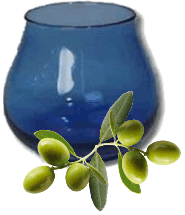Not all oils have the same taste!
The taste of olive oil depends on many factors including: the olive variety, agronomic management of plants (for example if they are irrigated or not), the health of the plants, the degree of maturity at which the olives are harvested and the method with which they are working. An often crucial aspect is represented by the purchase of oil and, therefore, its sensory evaluation. The choice of the type of oil to buy, is almost always a choice of taste, though, should choose oil according to the culinary combination to which we will attach it, but, in principle, it is always necessary to assess the quality of oil from three factors.
1-ESAME ALLVO
Contrary to what you may think, the Visual examination of the olive oil is not decisive for a sensory evaluation. The oil obtained after grinding is cloudy, opalescent and contains mucilage in suspension, air bubbles and water residues. After a rest period (settling), foreign matter deposited on the bottom: at this point we proceed to the transfer. Then the oil is usually subjected to a filtration that gives clear and bright color we know, avoiding that the permanence of vegetable particles causing fermentation processes and accelerate the phenomena of Rancidity. The color of the oil and its clarity is due to the presence in the product of liposoluble pigments such as chlorophyll, carotenes, xanthophylls and carotenoids. The prevalence of chlorophyll green oils we have, while a majority of carotenes and carotenoids gives the oil a yellow more or less intense. For those who have no experience in the taste of the oil, it is advisable, as mentioned, does not observe the color not to be influenced by our consumption habits. Each of us, in fact, has its own parameter for judging at sight a food: this, for non-experts, may compromise the objectivity of taste. For this reason, for the Professional tasting of oil using special glass cups with dark shades, normally dark blue.
2-The OLFACTORY TEST
The olfactory test is important because it allows you to express an evaluation on the characteristics of an aromatic oil, determined by the presence of volatile aromatic compounds. The olfactory examination is crucial to 50% in the evaluation of the organoleptic quality of an oil. The olfactory examination is done by putting a little oil (just a tablespoon) in a shot by taste or, failing this, in a plastic cup. The oil should be heated, taking the glass in hand and eventually covering it with your hand to prevent odors are dispersed in the air. Smell the sample for a few seconds, breathing deeply; Repeat the operation after a short period of time. It is useless to prolong the operation, because it creates an addiction to odors. We seek, first, to perceive the pleasant sensations and possibly unpleasant ones. We must then try to recognise the scents that are more familiar to us. Olfactory description of an oil, in fact, describing smells largely known to anyone. We think smells like those of citrus, artichoke, tomato and herbs. The skill, given mainly by the experience, is to recognize and remember odors known ones. For this reason, it can be helpful to learn to recognize some less common scent, for example that of fresh almonds or the fig leaf, useful in the description of a virgin olive oil. An important element to be recognized in the oil is the smell of olive oil, that is. In particular, the prevalence of smell of olive oil "is defined most immature green fruity" while the mature fruit is like sweet fruity or "mature". This fundamental distinction, often used in competitions reserved for Virgin olive oils, derives not only from the different degree of ripeness of the olives, but also from cultivars and cultivation areas. Can be useful, going to campaign during the olive harvest or in a mill, take some olives at different degrees of aging and try to spot the differences of the smell.
3-ACCESS ExaminationVO
Our taste identifies four basic tastes: sweet, salty, bitter and sour. The sense of taste lies in the taste buds that taste buds are present on any language. The perception of fundamental flavors is concentrated in different areas of the tongue: sweet, for example, better captures the tip of the tongue. To enjoy an oil you need to drink a small amount without swallowing. The oil must be distributed throughout the mouth, because in different areas of language you perceive different flavors. One thing to do is to inhale air through your nose and make her pass on the tongue, to oxygenate the oil. At this point we begin to decipher our feelings. We type tactile sensations, i.e. more or less oil or fluid more or less greasy, and sensations of taste type: from basic ones for an oil, the sweet, bitter and spicy, to more complex ones, that remind us of known flavors, such as sweet almond, artichoke, herbs.









